- News
- City News
- lucknow News
- How a two-room memorial school turned into a 225-acre Lucknow University
Trending
This story is from November 11, 2019
How a two-room memorial school turned into a 225-acre Lucknow University
In the summer of 1862, first viceroy of British India Charles John Canning breathed his last in London. Around 4,500 miles away, a bunch of loyal taluqdars in Awadh decided to donate eight anna (half a rupee) from their annual income to start an academic institution in his memory. Two years later, Canning High School was born.

Canning College was merged with Isabella Thoburn College and King George’s Medical College to form Lucknow University
In the summer of 1862, first viceroy of British India Charles John Canning breathed his last in London. Around 4,500 miles away, a bunch of loyal taluqdars in Awadh decided to donate eight anna (half a rupee) from their annual income to start an academic institution in his memory. Two years later, Canning High School was born. What began as a cradle with 200-odd students in two rooms of a haveli in the narrow lanes of Khayaliganj, Aminabad, is today one of the oldest residential universities of the country.
The University of Lucknow, which formally became a varsity in 1920, sprawls over 225 acre in Hasanganj and has over 1.5 lakh students across its campuses and affiliated colleges.

As the university steps into its centenary year on November 25, here’s looking back in pride at its interesting genesis.
First academic session began in July 1921
They managed to open a school (instead) at Aminuddaulah Palace in present-day Aminabad on May 1, 1864. There were 200 students on the rolls till Class X,” historian Yogesh Praveen told TOI.
In 1866, the high school was elevated to Canning College. In the early days, the college had no building of its own and had an almost peripatetic existence, shifting from one place to another, including Lal Baradari where Lalit Kala Academy is housed at present. It got a building of its own in Kaiserbagh (currently, Rai Umanath Bali Auditorium and Bhatkhandey Music Institute), but the growing demand for space prompted another relocation. In 1878, Canning College finally had a permanent address in Badshah Bagh, Hasanganj, where it stands even today. The foundation stone of the new building was laid by Sir John Lawrence on November 13, 1867, but it took around 11 years to be ready.
The main building was patterned in Indo-Saracenic style with high ceiling and wooden stairways. It was formally inaugurated by Sir George EW Couper, then lieutenant-governor of northwestern provinces and chief commissioner of Oudh on November 15, 1878.
Canning College remained a recognised institution under Calcutta University for 20 years from 1867 till it came under the jurisdiction of Allahabad University in 1888. The University of Lucknow Bill was introduced in the Legislative Council on August 12, 1920. It was referred to a select committee that passed it after amendments on October 8, 1920. Canning College was merged with Isabella Thoburn College and King George’s Medical College to form the university.
GN Chakravarti, then pro-vice-chancellor of Banaras Hindu University (BHU), was made the first vice-chancellor of University of Lucknow on December 16, 1920. The academic session began in July 1921 and the first convocation was held in October 1922.
The University of Lucknow, which formally became a varsity in 1920, sprawls over 225 acre in Hasanganj and has over 1.5 lakh students across its campuses and affiliated colleges.

As the university steps into its centenary year on November 25, here’s looking back in pride at its interesting genesis.
According to a document from 1906, attributed to Mohammed Tasadduqi Khan — the Raja of Jehangirabad Oudh (now Barabanki district), the taluqdars wanted to build a college in honour of Lord Canning on a plot of land in Kaiserbagh that the viceroy had once gifted them.
First academic session began in July 1921
They managed to open a school (instead) at Aminuddaulah Palace in present-day Aminabad on May 1, 1864. There were 200 students on the rolls till Class X,” historian Yogesh Praveen told TOI.
In 1866, the high school was elevated to Canning College. In the early days, the college had no building of its own and had an almost peripatetic existence, shifting from one place to another, including Lal Baradari where Lalit Kala Academy is housed at present. It got a building of its own in Kaiserbagh (currently, Rai Umanath Bali Auditorium and Bhatkhandey Music Institute), but the growing demand for space prompted another relocation. In 1878, Canning College finally had a permanent address in Badshah Bagh, Hasanganj, where it stands even today. The foundation stone of the new building was laid by Sir John Lawrence on November 13, 1867, but it took around 11 years to be ready.
The main building was patterned in Indo-Saracenic style with high ceiling and wooden stairways. It was formally inaugurated by Sir George EW Couper, then lieutenant-governor of northwestern provinces and chief commissioner of Oudh on November 15, 1878.
Canning College remained a recognised institution under Calcutta University for 20 years from 1867 till it came under the jurisdiction of Allahabad University in 1888. The University of Lucknow Bill was introduced in the Legislative Council on August 12, 1920. It was referred to a select committee that passed it after amendments on October 8, 1920. Canning College was merged with Isabella Thoburn College and King George’s Medical College to form the university.
GN Chakravarti, then pro-vice-chancellor of Banaras Hindu University (BHU), was made the first vice-chancellor of University of Lucknow on December 16, 1920. The academic session began in July 1921 and the first convocation was held in October 1922.
End of Article
FOLLOW US ON SOCIAL MEDIA










